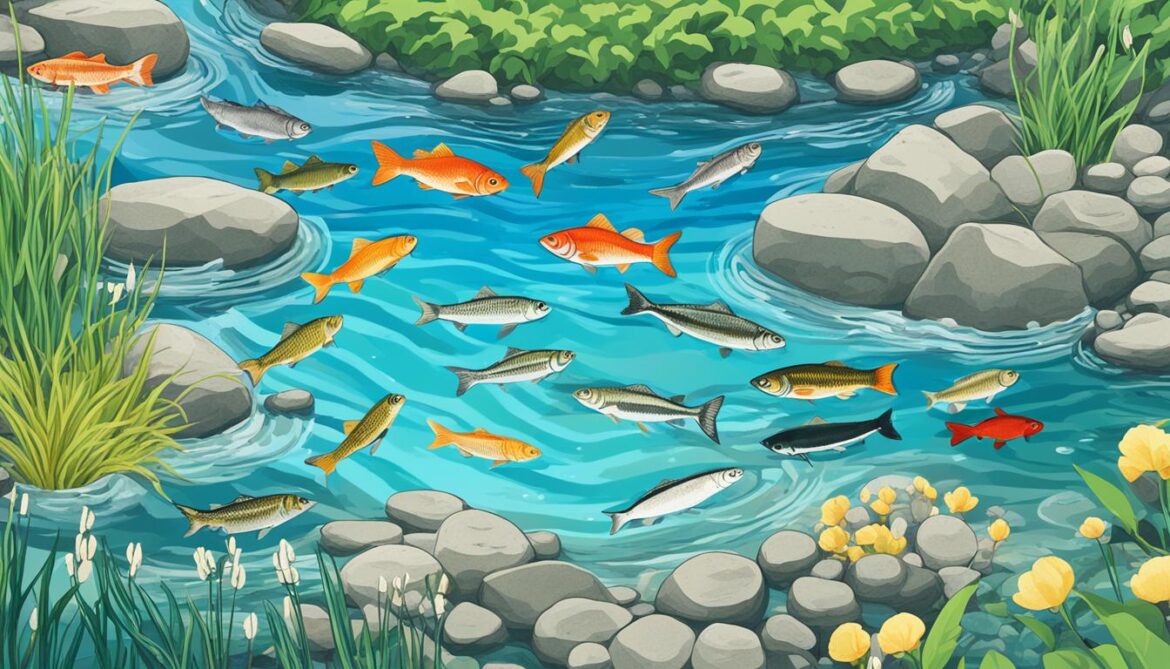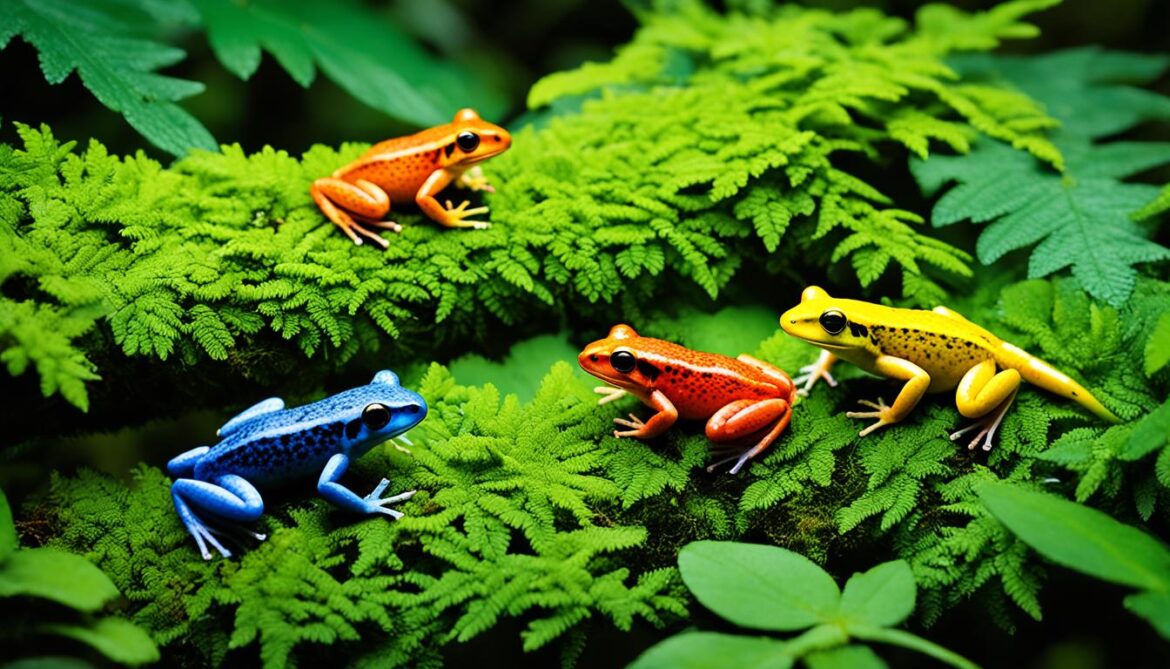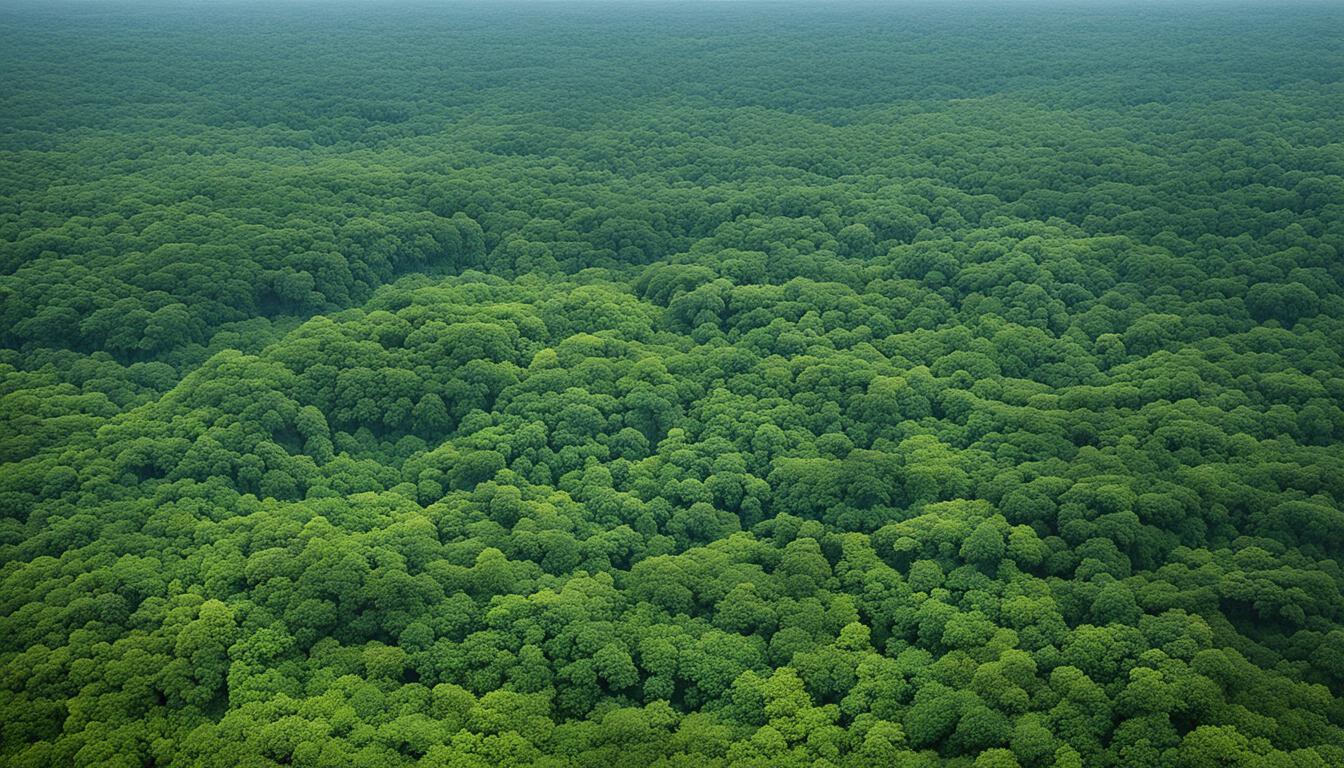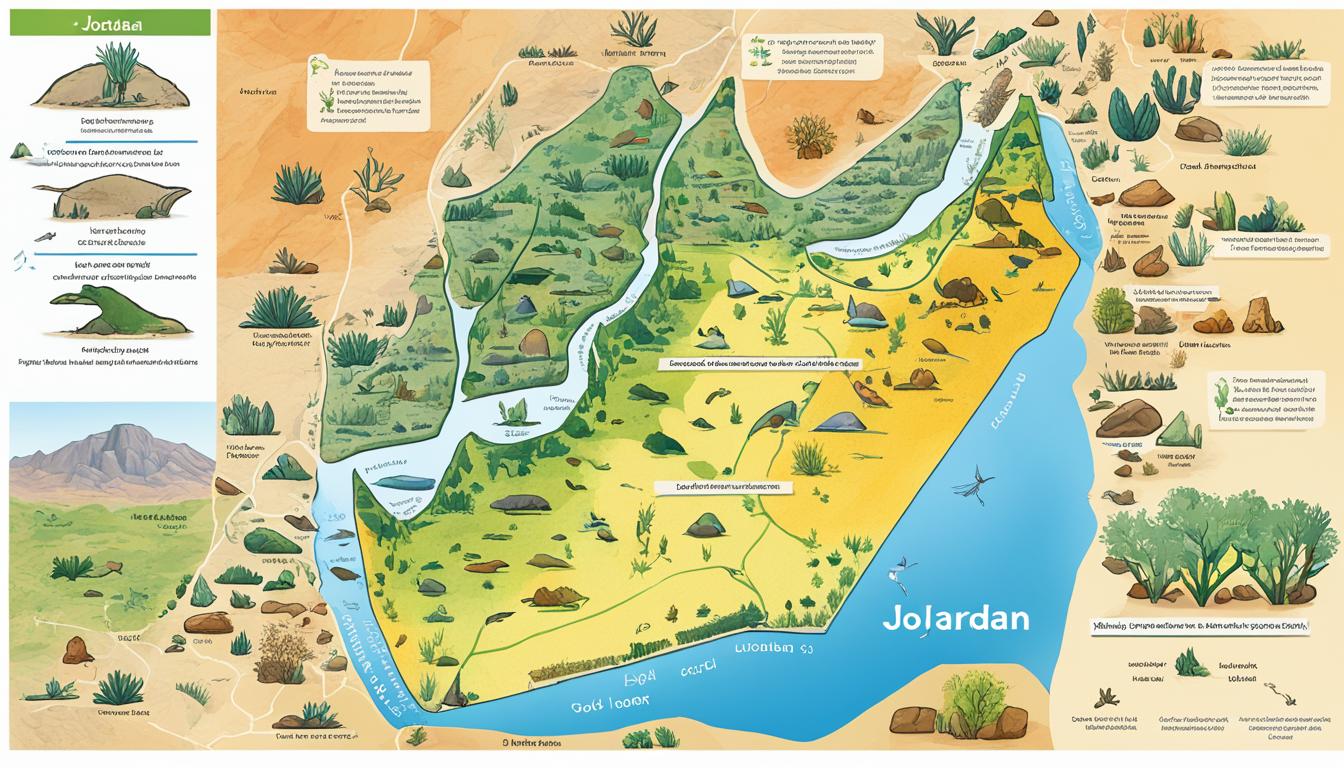Japan Biodiversity: Animal and Plant Species and What Is Under Threat
Japan is renowned for its remarkable biodiversity, encompassing a diverse array of animal and plant species. With over 90,000 known species and the potential inclusion of unclassified species, Japan’s biodiversity is estimated to exceed 300,000. The country boasts a high rate of endemic species, with nearly 40% of land mammals and vascular plants, 60% of reptiles, and 80% of amphibians found exclusively in Japan.
The surrounding seas also contribute to Japan’s rich biodiversity, with 50 of the world’s 127 marine mammals, 122 of the world’s 300 sea birds, and 3,700 marine fish species calling these waters home. However, Japan faces significant conservation challenges.
Key Takeaways:
- Japan’s biodiversity is estimated to exceed 300,000 species.
- Nearly 40% of land mammals and vascular plants in Japan are endemic.
- The surrounding seas are home to a diverse range of marine species.
- Conservation challenges threaten Japan’s biodiversity.
- Efforts are underway to protect and preserve endangered species in Japan.
Rich Biodiversity in Japan
Japan, despite its small land area of about 38 million hectares, boasts a rich biota. The country is estimated to have over 90,000 known species, and when unclassified species are included, the number exceeds 300,000. Japan also has a high rate of endemic species, with nearly 40% of land mammals and vascular plants, 60% of reptiles, and 80% of amphibians found only in the country. The surrounding seas also contribute to Japan’s biodiversity, with 50 of the world’s 127 marine mammals, 122 of the world’s 300 sea birds, and 3,700 marine fish species. This diversity is a result of various ecosystems found throughout the country.
From the lush forests of Hokkaido to the coral reefs of Okinawa, Japan’s diverse landscapes provide habitats for a wide range of species. The country’s rich biota is a testament to its unique geographical location and climatic variations. The mountains, rivers, lakes, and coastal areas are teeming with life, each supporting its own distinct ecosystem.
The Wonders of Marine Diversity
Japan’s marine diversity is particularly remarkable. The surrounding seas are home to a vast array of marine creatures, including whales, dolphins, sea turtles, and countless fish species. With 50 of the world’s 127 marine mammal species, Japan plays a vital role in global marine conservation efforts.
The marine ecosystems of Japan are a treasure trove of biodiversity, supporting fragile habitats and sustaining a multitude of species. From the majestic humpback whales in the Ogasawara Islands to the vibrant coral reefs of Ishigaki Island, the marine diversity in Japan is truly awe-inspiring.
The Richness of Endemic Species
Japan’s rich biota is further enhanced by its high rate of endemic species. These species, found nowhere else in the world, are a testament to Japan’s unique evolutionary history. Nearly 40% of land mammals and vascular plants, 60% of reptiles, and 80% of amphibians in Japan are endemic, showcasing the country’s exceptional biodiversity.
Endemic species play a crucial role in maintaining the balance of ecosystems and are often more susceptible to environmental changes. Protecting these unique species is vital for preserving Japan’s natural heritage and ensuring the long-term sustainability of its ecosystems.
Conservation of Japan’s Biodiversity
Recognizing the importance of preserving its rich biodiversity, Japan has implemented various conservation measures. National parks, wildlife protection areas, and nature reserves have been established to safeguard critical habitats. Additionally, the Japanese government has enacted legislation and regulations to protect endangered species and habitats.
“Conservation of Japan’s diverse biota is not only crucial for the preservation of biodiversity itself but also for the well-being of our society and the sustainable development of our country. It is our responsibility to protect and conserve the rich natural treasures that Japan possesses.” – Ministry of the Environment, Japan
Collaborative efforts between government agencies, NGOs, and local communities have also played a vital role in promoting conservation awareness and implementing sustainable practices.
Preserving the Future
Japan’s rich biota is a testament to the country’s natural wealth. From the vibrant forests to the vast seas, the diversity of life in Japan is truly remarkable. However, the preservation of this biodiversity is not without its challenges.
The rapid pace of urbanization, habitat loss, pollution, and climate change are all threats that must be addressed to ensure the long-term survival of Japan’s unique species and ecosystems.
Through continued conservation efforts, public awareness, and responsible environmental practices, Japan can safeguard its rich biota for future generations to enjoy.
Threatened Species in Japan
The conservation status of species in Japan is closely monitored through the Japanese Red List. This comprehensive database identifies and assesses the threats faced by numerous plants and animals across the country. According to the Red List, Japan is home to over 3,500 threatened species. Among them, endangered species make up more than 20% of mammals and vascular plants, over 10% of birds, and approximately 30% of reptiles, amphibians, and freshwater fishes.
These threatened species face a range of challenges and risks. Habitat destruction caused by activities such as land reclamation, development, and changes in land use is one of the major threats. Additionally, illegal digging and overexploitation for commercial purposes further contribute to the decline of these species.
To address these threats and protect the rich biodiversity of Japan, concerted conservation efforts are being undertaken. The National Biodiversity Strategy of Japan plays a crucial role in guiding these efforts, outlining specific conservation measures and strategies. This strategy emphasizes the importance of preserving and restoring habitats, implementing sustainable practices, and raising awareness about the value of biodiversity.
Conservation Efforts and the Japanese Red List
In Japan, the Japanese Red List serves as a valuable tool for prioritizing conservation actions and resource allocation. It provides essential information on the conservation status of species, highlighting the urgency and significance of ongoing efforts.
Conservation initiatives range from habitat restoration and management to species reintroduction programs. Protected areas, including national parks and wildlife protection areas, have been established to safeguard critical habitats for threatened species. These protected areas serve as refuges and enable the recovery of populations at risk.
A unique aspect of Japan’s conservation efforts is the collaboration between government agencies, nonprofit organizations, and local communities. This multi-stakeholder approach facilitates the implementation of effective conservation measures, combining scientific expertise with traditional ecological knowledge.
Through these collective efforts, progress is being made towards the preservation of Japan’s threatened species. Nonetheless, the continuous monitoring and adaptation of conservation strategies remain imperative to ensure the long-term survival of these species and the overall health of Japan’s diverse ecosystems.
| Threatened Species | % of Mammals and Vascular Plants | % of Birds | % of Reptiles, Amphibians, and Freshwater Fishes |
|---|---|---|---|
| Endangered | Over 20% | Over 10% | About 30% |

Ecosystems in Japan
Japan’s diverse ecosystems contribute to its rich biodiversity. Forests, natural vegetation, satochi-satoyama areas, coastal areas, and islands are all integral parts of Japan’s unique natural environment.
Forests
The country’s forests cover a significant portion of Japan’s land area, accounting for 67% of the total. These forests play a crucial role in maintaining the ecological balance and harboring a wide range of plant and animal species. Natural forests make up 17.9% of the forested area, providing habitats for various endemic and threatened species. Japan’s forested landscapes are not only visually captivating but also critical for conservation efforts.
Natural Vegetation
Japan’s natural vegetation, including forests and grasslands, thrives in the country’s mountainous regions. These natural mountain areas span nearly 20% of the land and support diverse plant communities. The lush vegetation provides essential habitats for many species, contributing to the overall biodiversity of Japan.
Satochi-Satoyama Areas
The satochi-satoyama areas in Japan are the result of centuries of human interaction with the landscape. These areas encompass artificial forests, rice paddy fields, and rural landscapes. Today, they cover approximately 40% of Japan’s land area. Satochi-satoyama areas serve as vital habitats for numerous threatened species and exemplify the harmonious coexistence of human activities and nature in Japan.
Coastal Areas and Islands
Japan’s extensive coastline and over 6,800 islands contribute to the country’s unique ecosystems. Coastal areas are home to a variety of marine life, including fish, mammals, and birds. However, these habitats are highly vulnerable to habitat destruction and the introduction of invasive species. The islands of Japan also contain distinct ecosystems that require protection from human activities and environmental threats.
“The conservation and preservation of Japan’s diverse ecosystems are crucial for maintaining the country’s rich biodiversity.” – Japanese Environmental Conservation Society
| Ecosystem | Features |
|---|---|
| Forests | Account for 67% of Japan’s land area |
| Natural Vegetation | Found in mountainous regions, covering nearly 20% of Japan’s land |
| Satochi-Satoyama Areas | Formed through human interactions, encompassing artificial forests, rice fields, and rural areas |
| Coastal Areas and Islands | Provide distinct ecosystems susceptible to habitat destruction and invasive species |
Conservation Efforts in Japan
Japan has taken significant steps to enhance the conservation of its biodiversity. The National Biodiversity Strategy of Japan, adopted in 2012, serves as a comprehensive roadmap for achieving the Aichi Biodiversity Targets. It outlines specific measures aimed at protecting and preserving the country’s unique natural heritage.
To support these conservation efforts, Japan has implemented legislation such as the Natural Parks Law, the Nature Conservation Law, and the Law for the Conservation of Endangered Species of Wild Fauna and Flora. These laws serve to safeguard various aspects of biodiversity, ranging from protected areas to endangered species.
Protected areas play a crucial role in conserving Japan’s habitats and species. These areas include national parks, wildlife protection areas, and natural scenic beauties. They are designated to ensure the preservation of crucial ecosystems and provide safe havens for vulnerable flora and fauna.
Furthermore, Japan has made notable progress in wildlife conservation through initiatives such as artificial breeding programs, feeding programs, and habitat improvement projects. These efforts aim to protect and restore habitats, promote species recovery, and mitigate the risks faced by endangered wildlife.

By combining the implementation of the National Biodiversity Strategy, the enactment of supportive legislation, the establishment of protected areas, and wildlife conservation programs, Japan is working towards a sustainable future for its diverse ecosystems and precious wildlife.
Endemic Species in Japan
Japan is renowned for its remarkable diversity of plant and animal life, including a significant number of endemic species that are found nowhere else in the world. Among these unique species, approximately one-third of Japan’s vascular plants are considered endemic, contributing to the country’s rich biodiversity.
Some notable examples of endemic animals include the Ryukyu wood-pigeon, Bonin wood-pigeon, Bonin thrush, and Bonin grosbeak. These bird species have evolved and adapted specifically to the ecological conditions found in Japan, making them particularly special and valuable to the country’s natural heritage.
Unfortunately, the survival of these endemic species is constantly threatened by various factors, including the introduction of non-native or exotic species. These invasions disrupt the delicate balance of ecosystems and can significantly impact the native flora and fauna, leading to potential extinction risks.
To protect and conserve these unique endemic species, Japan has implemented several conservation efforts. Habitat preservation plays a crucial role in maintaining the necessary conditions for these species to thrive. Wildlife protection laws ensure legal safeguards for these animals, discouraging any harm or disturbance to their natural habitats.
Furthermore, reintroduction programs are being conducted to reintroduce and reestablish endangered endemic species in suitable habitats where they have vanished or declined in numbers. These proactive measures aim to secure the long-term survival of these species and promote their recovery.

Through a combination of habitat preservation, wildlife protection laws, and reintroduction programs, Japan is dedicated to safeguarding its endemic species and preserving the unique biodiversity hotspots found within its borders. Recognizing the importance of these species, conservation efforts remain a priority as Japan continues its commitment to environmental protection.
Protecting Endangered Species in Japan
The conservation and protection of endangered species in Japan are of paramount importance. The Red Data Book of Japan, first published in 1991, serves as a crucial tool in this endeavor. This comprehensive publication identifies and catalogues threatened fauna and flora in the country, enabling informed conservation actions.
Legislation plays a vital role in wildlife protection in Japan. The Wildlife Protection and Hunting Law focuses on safeguarding birds and mammals, while the Law for the Conservation of Endangered Species of Wild Fauna and Flora specifically addresses the protection of other wildlife. These laws support the efforts to preserve and restore populations of endangered species.
Conservation actions encompass various initiatives aimed at combating the decline of endangered species. Artificial breeding programs are implemented to increase the population numbers of at-risk species, ensuring their survival for future generations. Additionally, feeding programs provide essential support to vulnerable animals, ensuring their nutritional needs are met.
The improvement of habitat conditions also plays a crucial role in protecting endangered species. Habitat improvement initiatives focus on restoring and preserving the natural environments that threatened species depend on for survival. These efforts provide essential resources and ensure suitable living conditions.
Conservation actions and the commitment to protect endangered species are essential for maintaining the ecological balance in Japan.
To provide a clear understanding of the importance of protecting endangered species in Japan, here is an illustrative example:
| Endangered Species | Conservation Actions |
|---|---|
| Japanese Crested Ibis | An artificial breeding program was established to increase the population numbers. Ongoing efforts focus on reintroducing captive-bred individuals into suitable habitats. |
| Iriomote Cat | Habitat conservation measures, such as restrictions on land use and the establishment of protected areas, aim to safeguard the critical habitats of this endangered feline species. |
| Amami Rabbit | Conservation efforts primarily focus on protecting the native forests on Amami Island, which provide crucial habitat for this endangered rabbit species. |
Through concerted efforts guided by the Red Data Book, strong legislation, and targeted conservation actions, Japan endeavors to protect and preserve its unique and valuable endangered species. By securing the future of these vulnerable organisms, we contribute to the overall health and integrity of Japan’s rich biodiversity.
Impacts on Biodiversity in Coastal Areas
Coastal areas in Japan are facing significant environmental stresses that negatively affect the biodiversity of marine ecosystems. These stresses include habitat degradation resulting from land reclamation and development. Such activities lead to the destruction and deterioration of habitats for numerous marine species. The loss of these habitats disrupts the delicate balance of coastal ecosystems, endangering the survival of various organisms.
The coastal areas also experience water pollution, further exacerbating the negative impacts on biodiversity. Due to industrial activities, harmful substances are introduced into the coastal waters, posing hazards to marine life. Moreover, reduced water flow from rivers to estuaries and coastal waters disrupts the natural flow dynamics necessary for the survival and reproduction of marine species.
Alien species introduction, oil spills, and coral bleaching caused by climate change further compound the challenges facing coastal biodiversity in Japan.
The introduction of alien species is another significant threat to coastal ecosystems. Non-native species can outcompete indigenous species, leading to imbalances in predation, competition, and resource availability. This disruption alters the natural interactions within coastal habitats and can have cascading effects throughout the entire ecosystem.
Oil spills are another major concern, as they release toxic substances into the marine environment. These spills can have devastating consequences for coastal biodiversity, damaging habitats, and causing mass mortalities of marine organisms. Additionally, climate change-induced coral bleaching poses a serious risk to the diverse coral ecosystems found in coastal areas. Rising water temperatures and changes in ocean chemistry can lead to the death of coral reefs, impacting countless species that depend on these habitats for their survival.
Overall, the cumulative impacts of habitat degradation, water pollution, introduction of alien species, oil spills, and coral bleaching threaten the biodiversity of coastal areas in Japan. To mitigate these challenges, it is vital to implement effective conservation measures and sustainable coastal management practices. Protecting and restoring coastal habitats, reducing pollution, and combating climate change are essential for preserving the unique marine ecosystems of Japan.

Conservation Initiatives for Freshwater Fish in Japan
Japan is renowned for its remarkable freshwater fish diversity, consisting of nearly 215 native species. Out of these, more than 50 are *endemic species*, found exclusively in Japan’s pristine waterways. Recognizing the importance of preserving these unique fish populations, Japan has implemented various *conservation measures* to ensure their long-term survival.
One of the primary initiatives is the establishment of *protected areas* that safeguard vital habitats for native fish species. These protected areas provide a haven where freshwater fish can thrive undisturbed, away from the pressures of human activities.
Furthermore, Japan has undertaken extensive *nature restoration projects* to restore and enhance the natural habitats of freshwater fish. By reclaiming degraded areas and reintroducing native vegetation, these projects contribute to the revitalization of freshwater ecosystems and the recovery of fish populations.
Preserving Evolutionary History
Conservation efforts in Japan extend beyond the protection of endemic species to include the preservation of the *evolutionary history of fishes*. Japan is home to ancient lineages of fish, such as *lampreys* and *sturgeons*, which have been in existence for millions of years. These evolutionary relics provide valuable insights into the history of life on Earth and serve as living records of past ecosystems.
By focusing on the conservation of these ancient lineages and their habitats, Japan aims to maintain the intricate balance of freshwater ecosystems and prevent the loss of irreplaceable biodiversity.

Conservation of Threatened Amphibians in Japan
Japan is renowned for its rich biodiversity, including a diverse range of endemic amphibian species. Out of the 50 amphibian species found in the country, an impressive 44 are unique to Japan. These endemic amphibians are of great conservation concern due to their vulnerability to environmental changes and habitat loss.
To protect these precious species, significant conservation efforts are underway in Japan. One notable initiative is the Satoyama Initiative, which focuses on preserving traditional agricultural ecosystems that serve as critical habitats for amphibians. By maintaining and restoring these cultural landscapes, the Satoyama Initiative aims to safeguard the biodiversity of endemic amphibians.
“Preserving traditional agricultural ecosystems is not only essential for food production but also for the conservation of endangered species like endemic amphibians. By striking a balance between human activities and nature, we can ensure the survival of these unique and invaluable creatures.” – Dr. Hiroshi Ishihara, Conservation Biologist

In addition to the Satoyama Initiative, efforts are being made to protect marine and coastal biodiversity, which also support amphibian populations. The conservation and development of underwater plant beds and tidelands play a crucial role in preserving the delicate balance of these ecosystems, thereby indirectly aiding the conservation of endemic amphibians.
Through habitat preservation and conservation initiatives like the Satoyama Initiative, Japan is actively working towards ensuring the long-term survival of its endemic amphibians. These efforts serve as a testament to the country’s commitment to preserving its unique and fragile biodiversity.
| Conservation Efforts for Endemic Amphibians in Japan | Impact |
|---|---|
| Preservation of traditional agricultural ecosystems through the Satoyama Initiative | Ensures critical habitats for endemic amphibians |
| Conservation and development of underwater plant beds and tidelands | Indirectly aids the conservation of amphibians |
Challenges in Protecting Japan’s Biodiversity
Protecting Japan’s biodiversity is no easy task, as the country faces numerous challenges that threaten its unique ecosystems. Three key challenges include habitat destruction, the introduction of invasive species, and the effects of climate change.
The Impact of Habitat Destruction
Habitat destruction poses a significant threat to Japan’s biodiversity. Land reclamation, development, and changes in land use have led to the destruction and fragmentation of vital habitats for many species. As natural areas are converted for human activities, wildlife populations decline, and species face the risk of extinction.
The Threat of Invasive Species
The introduction of invasive species further exacerbates the challenges faced in biodiversity conservation. Invasive species, often introduced unintentionally or as a result of human activities, disrupt native ecosystems and outcompete native species for resources. This can lead to a loss of biodiversity and ecological imbalance.
The Impact of Climate Change
Climate change poses a significant threat to Japan’s marine biodiversity, particularly through the phenomenon of coral bleaching. Rising sea temperatures and ocean acidification contribute to the bleaching of coral reefs, resulting in the loss of these productive and diverse ecosystems. Additionally, climate change alters weather patterns, which can impact the distribution and survival of many species.
“Habitat destruction, the introduction of invasive species, and climate change all contribute to the challenges faced in protecting Japan’s biodiversity. Addressing these challenges requires the implementation of effective conservation strategies and collaborative efforts.”
Conservation Strategies to Safeguard Biodiversity
Recognizing these challenges, Japan has implemented various conservation strategies to protect its biodiversity. The National Biodiversity Strategy of Japan provides a comprehensive framework for conservation efforts, focusing on sustainable management and the restoration of ecosystems. Protected area designations, such as national parks and wildlife protection areas, contribute to habitat preservation and provide safe havens for endangered species.
In addition, habitat restoration projects play a vital role in conserving biodiversity. By restoring degraded habitats and enhancing their resilience, these projects help create healthier ecosystems that can support a greater diversity of species.

| Conservation Strategy | Description |
|---|---|
| National Biodiversity Strategy | An overarching framework that guides biodiversity conservation efforts at the national level. |
| Protected Area Designations | Establishing protected areas, such as national parks and wildlife protection areas, to conserve habitats and species. |
| Habitat Restoration Projects | Efforts to restore degraded habitats and enhance their resilience, promoting the recovery of biodiversity. |
By implementing these conservation strategies and raising awareness about the importance of protecting biodiversity, Japan strives to safeguard its unique ecosystems for future generations.
Conclusion
Japan’s rich biodiversity is under threat from rapid economic development, habitat destruction, and the introduction of invasive species. To protect and restore this valuable resource, conservation efforts are underway. The implementation of the National Biodiversity Strategy, the establishment of protected areas, and the adoption of specific measures for endangered species are key steps towards environmental protection. It is crucial to continue these conservation efforts to ensure the long-term survival of Japan’s unique ecosystems and the many endangered species that call this country home.








